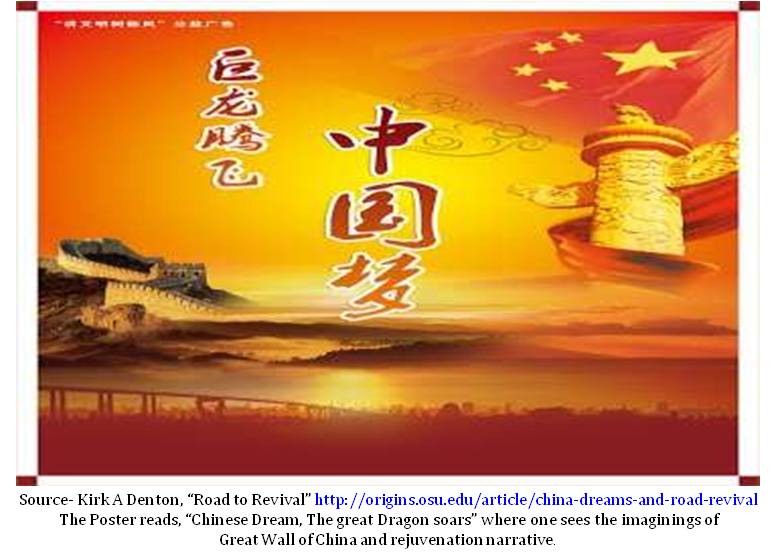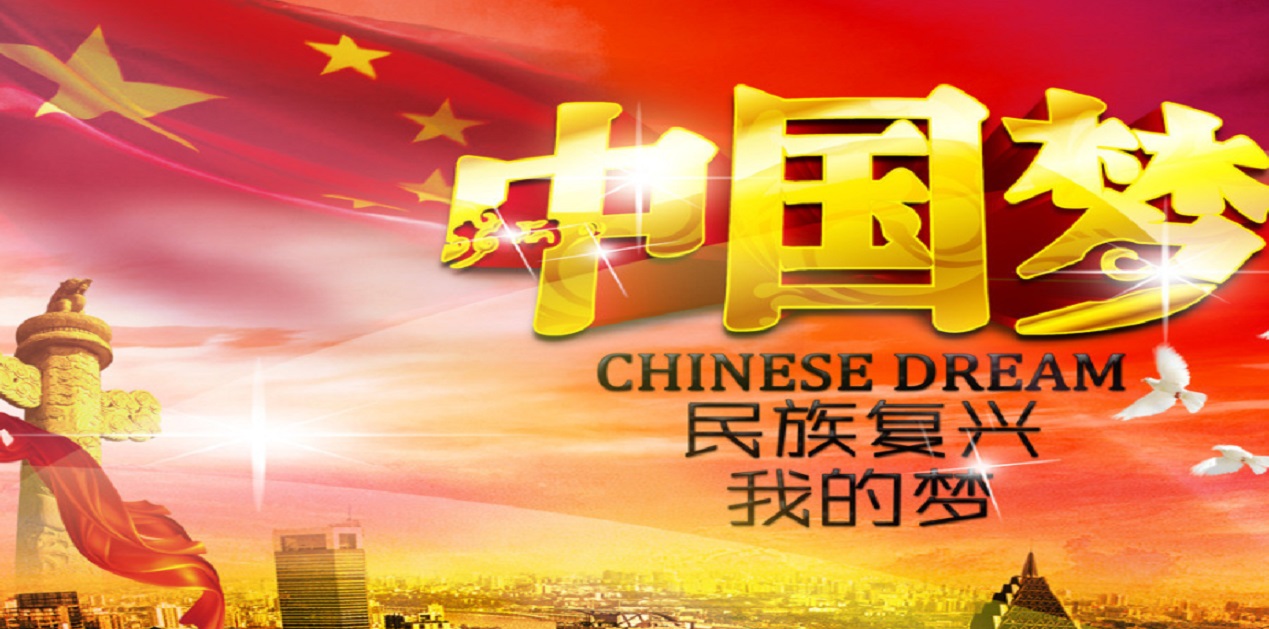The oft-quoted slogan “Chinese dream” by the President Xi Jinping, which was under spotlight when it was introduced, has gained widespread attention and jitters in China and the outside world. Inside China, the Chinese dream is everywhere, on streets, in cinemas, in music and even in schools. The Chinese dream is reminder for the Chinese that there will be rejuvenation of the country to its past glory. Outside China, the dream is a cause of concern - of an impending hegemonic Chinese world order.
Chinese leaders have been quite artful in the ways they have communicated their ideologies to the people. Over the years Chinese leaders have crafted catchy phrases to attract people’s attention. From Mao Zedong’s “Class struggle”, Deng Xiaoping’s “Four modernization”, Jiang Zemin’s “Three represents” to Hu Jintao’s “Harmonious society”, Chinese leaders have used these phrases to underscore the centrality of their ideologies1. Since Xi Jinping took office in November 2012, he has promoted the concept, “the Chinese Dream.” In fact in his majority of public speeches the recurring theme has been around the Chinese dream.
He first made remarks about the zhong guo meng (Chinese dream) on 29 November 2012, just days after being elected General Secretary of the Central Committee of the CPC. It was his visit to the exhibition “Road to Revival” at the National historical Museum where he provocatively declared, “Rejuvenation of Chinese nation is the greatest Chinese dream”. Xi explained the dream by emphasizing that by the time CPC celebrates 100th anniversary of its foundation, China will be “prosperous, strong, democratic, civilized and harmonious socialist modernized country”.2 The goals set by Xi Jinping were big and overtly ambitious. For Xi Jinping as he said that Chinese dream requires to achieve the “Two 100s”. “The first hundred requires China becoming a “moderately well off society” by about 2020 and the second 100 requires accomplishment of the “modernization goal” of China becoming a fully developed nation by about 2050”.3
Chinese dream rests on four pillars: “Strong China (economically, politically, diplomatically, scientifically, militarily); Civilized China (equity and fairness, rich culture, high morals); Harmonious China (amity among social classes); Beautiful China (healthy environment, low pollution).”4 The core idea is to rejuvenate the nation and ignite a collective aspiration for a moderately prosperous nation. The idea was not become a world superpower but to gain back what can be described as a sort of “natural” (for China) leadership.

At the 19th Party Congress in October 2017, the CCP amended its Party Constitution to enshrine Xi’s concept of “the Chinese Dream of national rejuvenation.” Xi emphasized the fidelity of his synthesis of Chinese communism and Chinese nationalism to the party’s fundamental teachings: “At its founding,” he said, “the Communist Party of China made realizing communism its highest ideal and its ultimate goal, and shouldered the historic mission of national rejuvenation.”5 It is not the first time Chinese leaders have used the rejuvenation narrative, in fact historically Sun Yat Sen, Hu Jintao and Jiang Zemin have talked about rejuvenation of the Chinese nation but under “Xi Jinping it is different because he talks “about the possibility to achieve it within this lifetime”. Hence unlike the previous slogans of Hu Jintao and Jiang Zemin the Chinese dream by Xi Jinping is all about ‘optimistic dreaming’ about better world in which China will recover to its rightful place in history. Xi has blatantly declared that under the Chinese dream there will be “Wiping out of the humiliation of the Chinese nation for centuries”. To showcase its “benign intentions” Chinese dream is also “rhetorically constructed with references to essentialized Confucian reality” and actualized in self-proclaimed tangible reality.
The interesting aspect about Chinese dream is that it is not just a domestic issue but has global resonances. Xi Jinping promoted the Chinese dream as the world dream, a “harmonious” dream tailored to every civilization and localized to every country. Belt and Road Initiative became an important element of “Chinese Dream” which encompasses the country’s strategy from establishing supremacy in Asia and attaining global ascendancy. BRI is a narrative of China’s peaceful model of growth and development, particularly for the less developed neighbours and isolated regions in Africa. Hence Chinese dream is also coterminous with China’s soft power diplomacy6.
It is pertinent to understand that Chinese dream is not just another slogan but it has become the ideological core of Xi Jinping’s administration. Through Chinese dream, Xi Jinping is trying hard to sell the “China story” domestically and abroad. However, the dream is divorced from the harsh ground realties. The question that arises is that is the Chinese dream all-inclusive?
The Chinese realities are bewildering and Chinese dream is enmeshed in paradoxes. Under Xi Jinping there is an increased surveillance and a clampdown on Chinese society. There is also growing repression and grave human rights violations of minority communities especially the Uighurs and Tibetan Buddhists. Chinese dream then remains centric to the Han community7. Internationally, the Belt and Road Initiative is facing a setback as the issues of debt trap, lack of transparency and environmental degradation are emerging in majority of the developing countries. It’s becoming clearer that under the garb of “community of shared destiny”, Xi Jinping wants to establish a Sino centric world order.
The year 2020 has further exposed the fragility of the concept. Domestically there has been instability in China as early 2020 saw the pro-independence Democratic Progressive Party (DPP) in Taiwan and protests in Hong Kong gaining momentum8. In fact, 2020 was supposed to be pivotal year for the Chinese dream “the year of realizing a well-to-do society for all of China”9. China had targeted to eliminate absolute poverty and raise the living standard of its people. Xi Jinping stressed “racing against time to reach Chinese dream”. However, the outbreak of Covid-19 disease, which originated in Wuhan province of China, has put a question mark on theChinese dream. The Covid-19 crisis has exposed China’s incompetence and its perfidious nature towards its own people. Due to the mishandling of the crisis, China has to deal with mounting domestic challenges from labour unrest to unemployment and demographic decline. Internationally, there is a global backlash against China for its mishandling of the covid-19 crisis10. China is also engaged in politico-military face-offs with India, United States, Japan and many small Southeast Asian nations. These face-offs have exposed China’s revanchist and expansionist ambitions, which is in contrast to the idea of harmonious world dream.
We need to understand that Chinese dream is not just a happy dream. Unlike in democratic societies where dreaming is “free” and extensively discussed, under the authoritarian Chinese government dreams are also subject to scrutiny and surveillance. Chinese dream hence remains vague, aspirational and open ended. It makes China look confident yet anxious, benign yet hegemonic and peaceful yet dangerous. Further with the outbreak of Covid-19 disease the future of Chinese dream looks bleak and it remains a fantasy for the coming decade.
References-
- https://www.vifindia.org/article/2015/november/24/third-anniversary-of-xi-s-china-dream
- Xi pledges “great renewal of Chinese nation”, Xinhua, 29 November 2012, http://www.xinhuanet.com//english/china/2012-11/29/c_132008231.htm
- Ibid
- https://www.sundayguardianlive.com/opinion/china-dream-xi-needs-wake-call
- Xi Jinping, “Secure a Decisive Victory in Building a Moderately Prosperous Society in All Respects and Strive for the Great Success of Socialism with Chinese Characteristics for a New Era”, pp. 11-12.
- https://www.orfonline.org/expert-speak/covid-19-and-its-aftermath-impact-on-chinas-soft-power-67754/
- https://thediplomat.com/2016/06/could-han-chauvinism-turn-the-chinese-dream-into-a-chinese-nightmare/
- https://economictimes.indiatimes.com/news/international/world-news/view-xi-may-have-lost-the-plot-on-chinas-dream-of-great-rejuvenation/articleshow/76679355.cms?from=mdr
- https://thehill.com/opinion/finance/506705-economic-slump-the-china-dream-shattered
- https://www.nytimes.com/2020/05/03/world/europe/backlash-china-coronavirus.html
(The paper is the author’s individual scholastic articulation. The author certifies that the article/paper is original in content, unpublished and it has not been submitted for publication/web upload elsewhere, and that the facts and figures quoted are duly referenced, as needed, and are believed to be correct). (The paper does not necessarily represent the organisational stance... More >>
Image Source: http://images.china.cn/attachement/png/site1007/20130528/7427ea210acc130e5eda21.png











Post new comment